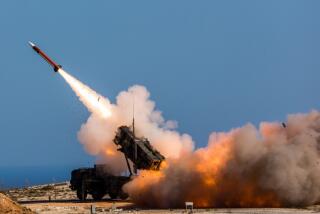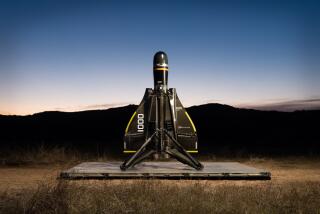Patriot Missile, Even Improved, Still Trails Controversy
WASHINGTON — From its first fiery launch 10 years ago during the Persian Gulf War, the Patriot antimissile system has been tailed by controversy.
To admirers it was the hero “Scud buster” that shielded U.S. troops from Iraqi missiles; to critics, a hyped hardware that missed far more warheads than it destroyed.
This month, the first units of a new Patriot missile will be delivered from an Arkansas assembly plant to an Army air defense battalion at Ft. Bliss, Texas. The new system has won wide praise for its ability to protect troops from short-range missiles, and some defense officials say that after half a century of research it is America’s first effective antimissile system.
Yet on the larger missile defense issue--whether the United States should spend billions on a system to protect the entire country from longer-range missiles--it is already clear that the new Patriot will be no less controversial than the old.
Advocates already offer it as proof that the Pentagon can succeed at the much more challenging job of dealing with high-speed, long-range missiles. Critics, likewise, hold it out as evidence that such an effort will be considerably more costly, difficult and time-consuming than advocates admit.
In fact, the 36-year effort to develop an effective Patriot “shows both,” said James M. Lindsay, a Brookings Institution expert and former National Security Council aide. “That’s why both sides point to it as a symbol.”
All sides agree that the new Patriot Advanced Capability 3 (PAC-3) will fill one of the most urgent needs of the U.S. military.
Short-range missiles like the Scud are now in the arsenals of about two dozen countries. They are wildly inaccurate, but with a range of a few hundred miles, the missiles could cripple U.S. military operations with strikes on troops, ports, air bases and allied cities.
In the Persian Gulf War, 28 U.S. soldiers died and 99 were injured when a Scud struck a barracks in Dhahran, Saudi Arabia.
It was “the worst single engagement of the war” and demonstrated that “we had underestimated the ballistic missile threat,” Paul D. Wolfowitz, the deputy Defense secretary, said in July testimony to Congress.
In response to the Scud threat, U.S. forces deployed the first version of the Patriot, which had been designed primarily for the less-challenging job of knocking down enemy aircraft.
Then-President Bush claimed these systems knocked down 41 missiles in 42 tries in the war. But critics soon offered evidence that the Patriots had actually hit metal debris broken loose by the Scuds’ atmospheric reentry, not warheads.
While some still defend the Patriot’s effectiveness, former Defense Secretary William S. Cohen said flatly last January that in 1991 the earlier Patriot “didn’t work.”
After the war, the Army began a redesign that has resulted in a rebuilt alignment for all the Patriot’s principal parts.
While the proposal to build a national missile defense is controversial because it would undermine arms control agreements, politicians of both parties strongly support building defenses against shorter-range missiles.
When Clinton administration officials came into office in 1993, they slowed plans for a national missile defense while pouring billions in new money into the Patriot and other short-range antimissile programs.
The Patriot’s mission is to protect against enemy aircraft, low-flying cruise missiles and short- and medium-range ballistic missiles.
The system consists of a launcher that sits on a truck bed and carries up to 56 missiles; a ground radar that finds and tracks threatening missiles and planes; and an “engagement control station” where operators sit.
The new Patriot has a more fine-grained radar that will enable operators to distinguish enemy warheads from other flying objects. The missile is more maneuverable than its predecessor, in part because of the addition of 180 tiny rocket thrusters, embedded near its nose.
Probably its biggest improvement is in the way it goes about destroying its target.
The earlier Patriot missile was designed to destroy the enemy projectile by exploding within several yards of the warhead and releasing a hail of metal fragments.
Guided by the more accurate radar, the new system is designed to strike the target directly, making it more likely that the metal-encased warhead will be destroyed.
Current plans call for the new Patriot missile to be tested in combat-like conditions from January until May. Then the Army and senior defense officials will decide whether to approve full-rate production of the missile.
In flight tests over the last five years, the Patriot struck its targets eight out of nine times.
But some defense officials and outside experts caution that the Patriot’s effectiveness in battle won’t be fully known until the Army subjects the equipment to the last few months of tests.
The system won’t be fully proved until it has been subjected to “real honest-to-gosh operational tests,” said Philip E. Coyle, the chief Pentagon weapon tester during the Clinton administration.
Army officials insist the technology won’t need big changes at this point, in part because of their experience using the earlier Patriot. Some outside analysts agree.
“This has been a very, very good [missile defense] development program, compared to almost any others,” said Duncan Lennox, editor of Jane’s Strategic Weapons Systems, in London. “I think it’s already very mature.”
The Patriot is likely to be a moneymaker for the missile’s contractor, Lockheed Martin Corp., Lennox said. Some industry officials believe that in addition to the 2,200 missiles the Army wants, Lockheed Martin may be able to sell more than 1,000 to allied countries.
Though deployment of the new Patriot might not take place for several years, some missile defense advocates have focused on it as an argument for proceeding with national missile defense.
“Not only can you hit a bullet with a bullet, we’ve been doing it repeatedly,” said Rep. Duncan Hunter (R-Alpine), chairman of the House Armed Services Committee’s research and development subcommittee, in a congressional hearing last summer.
Others contend that the Patriot’s success shows only that, given a lot of time and money, the Pentagon can devise a system to work against a less-challenging threat.
They note that the Patriot is designed to deal with missiles that travel at one-third the speed and about one-tenth the range of an ICBM. They also point out that the PAC-3’s development has been underway since 1965 and that the program has encountered repeated delays and cost overruns.
The program cost $6.9 billion from 1994 to 2000, the General Accounting Office found last year, jumping 77% during that period.
Brookings analyst Lindsay, co-author of “Defending America” and an advocate of limited missile defense, praises the Patriot program. But he says there’s a big leap from the PAC-3 to defense against high-speed, long-range missiles.
Equating the two “is like saying, since I can hit an underhand pitch from my Uncle Frank in the backyard I’m ready for a ball from [Dodgers pitcher] Kevin Brown,” he said.
The senior Army officer on the program, Col. Tommie E. Newberry, acknowledges that the effort has been more costly, time-consuming and complex than predicted.
“We have spent more money than we expected and it has taken two years longer,” said Newberry. “When you get into cracking the nut on some of the science, it’s more difficult than you anticipated.”
Yet Newberry predicted that the new Patriot would prove such an improvement that “I think anybody would say that it’s well worth the investment and the wait.”
More to Read
Sign up for Essential California
The most important California stories and recommendations in your inbox every morning.
You may occasionally receive promotional content from the Los Angeles Times.











